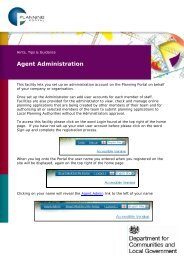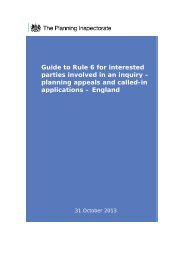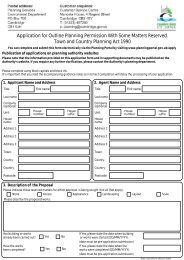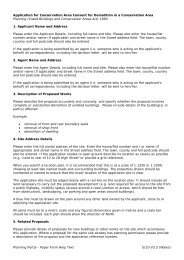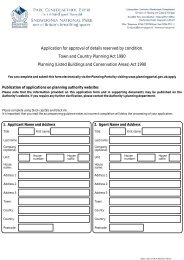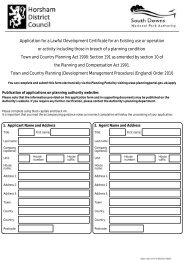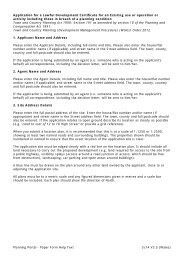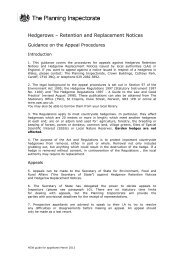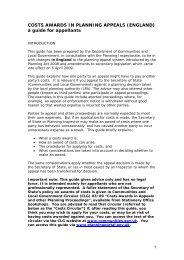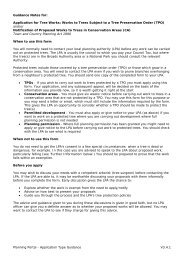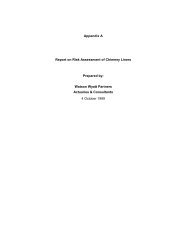Application for Approval of Reserved Matters ... - Planning Portal
Application for Approval of Reserved Matters ... - Planning Portal
Application for Approval of Reserved Matters ... - Planning Portal
Create successful ePaper yourself
Turn your PDF publications into a flip-book with our unique Google optimized e-Paper software.
<strong>Application</strong> <strong>for</strong> <strong>Approval</strong> <strong>of</strong> <strong>Reserved</strong> <strong>Matters</strong> Following Outline <strong>Approval</strong><br />
Article 21 Town & Country <strong>Planning</strong> (General Development Procedure) Order 1995<br />
1. Applicant Name and Address<br />
Please enter the Applicant Details, including full name and title. Please also enter the house/flat<br />
number and/or name (if applicable) and street name in the Street address field. The town, county,<br />
country and full postcode should also be entered.<br />
If the application is being submitted by an agent (i.e. someone who is acting on the applicant's<br />
behalf) all correspondence, including the decision letter, will be sent to him/her.<br />
2. Agent Name and Address<br />
Please enter the Agent Details, including full name and title. Please also enter the house/flat number<br />
and/or name (if applicable) and street name in the Street address field. The town, county, country<br />
and full postcode should also be entered.<br />
If the application is being submitted by an agent (i.e. someone who is acting on the applicant's<br />
behalf) all correspondence, including the decision letter, will be sent to him/her.<br />
3. Site Address Details<br />
Please enter the full postal address <strong>of</strong> the site. Enter the house/flat number and / or name (if<br />
appropriate) and street name in the Street address field. The town, county and full postcode should<br />
also be entered. If the application relates to open ground describe its location as clearly as possible<br />
(e.g. ‘Land to rear <strong>of</strong> 12 to 18 High Street’ or provide a grid reference).<br />
When you submit a location plan, it is recommended that this is at a scale <strong>of</strong> 1:1250 or 1:2500,<br />
showing at least two named roads and surrounding buildings. The properties shown should be<br />
numbered or named to ensure that the exact location <strong>of</strong> the application site is clear.<br />
The application site must be edged clearly with a red line on the location plan. It should include all<br />
land necessary to carry out the proposed development (e.g. land required <strong>for</strong> access to the site from<br />
a public highway, visibility splays (access around a road junction or access, which should be free<br />
from obstruction), landscaping, car parking and open areas around buildings).<br />
A blue line must be drawn on the plan around any other land owned by the applicant, close to or<br />
adjoining the application site.<br />
All plans must be to a metric scale and any figured dimensions given in metres and a scale bar<br />
should be included. Each plan should show the direction <strong>of</strong> North.<br />
4. Pre-application Advice<br />
The local authority may be able to <strong>of</strong>fer (possibly <strong>for</strong> a fee) pre-application discussions be<strong>for</strong>e a<br />
<strong>for</strong>mal application is submitted in order to guide applicants through the process. This can minimise<br />
delays later in processing the application.<br />
Pre-application discussions can also help you and the planning authority identify areas <strong>of</strong> concern<br />
about your proposed development so that you can give consideration to amending your proposal<br />
be<strong>for</strong>e the application is submitted. The advice and guidance given to you at the pre-application<br />
stage is given in good faith. However, it does not guarantee or supply a definitive undertaking as to<br />
whether your proposal is likely to be acceptable.<br />
If you have received pre-application advice from the planning service please indicate the<br />
reference/date <strong>of</strong> any correspondence or discussion and the name <strong>of</strong> the <strong>of</strong>ficer. If you do not know<br />
these details then please state ‘Unknown’.<br />
This will assist the Council in dealing with your application as quickly as possible.<br />
<strong>Planning</strong> <strong>Portal</strong> - Paper Form Help Text Sc23 V3.5
5. Development Description<br />
Please describe the proposal accurately and concisely, and specify the reserved matter(s) (ie access,<br />
appearance, landscaping, layout and scale) <strong>for</strong> which you are seeking consent.<br />
Example:<br />
• provision <strong>of</strong> principal access <strong>of</strong>f London Road and secondary access <strong>of</strong>f cul-de-sac to rear <strong>of</strong><br />
the site and other internal circulation roads<br />
• provision <strong>of</strong> landscaping details including 3 metre boundary hedge and 2 metre close boarded<br />
fencing to sides and rear <strong>of</strong> site<br />
• submission <strong>of</strong> layout and scale details comprising five-storey residential block to the rear <strong>of</strong><br />
the site, three-storey <strong>of</strong>fice block fronting London Road and recycling facilities including bin<br />
store on the western boundary<br />
• details <strong>of</strong> scale and appearance <strong>of</strong> the proposed three-storey dwelling including timber sash<br />
windows, slate ro<strong>of</strong> and red stock bricks<br />
If an environmental statement was submitted to the planning authority at the outline stage, the<br />
authority will need to check that it satisfies the requirements <strong>of</strong> the EIA Regulations at the reserved<br />
matters stage be<strong>for</strong>e approval can be granted.<br />
6. Council Employee/Member<br />
You must declare whether the applicant or agent is a member <strong>of</strong> the council’s staff, an elected<br />
member <strong>of</strong> the Council or related to a member <strong>of</strong> staff or elected member <strong>of</strong> the Council.<br />
Serving elected members or planning <strong>of</strong>ficers who submit their own planning applications should<br />
play no part in their determination and such applications should be determined by the planning<br />
committee rather than by planning <strong>of</strong>ficers under delegated powers.<br />
For the purposes <strong>of</strong> this question, 'related to' means related, by birth or otherwise, closely enough<br />
that a fair-minded and in<strong>for</strong>med observer, having considered the facts, would conclude that there<br />
was a real possibility <strong>of</strong> bias on the part <strong>of</strong> the decision-maker in the local planning authority.<br />
7. Supporting In<strong>for</strong>mation<br />
You should clearly make reference to drawings that <strong>for</strong>med part <strong>of</strong> the original decision and identify<br />
all plans submitted as part <strong>of</strong> this application. If applicable, an explanation or additional<br />
supplementary in<strong>for</strong>mation highlighting changes and variations should also be provided in support <strong>of</strong><br />
your submission.<br />
In circumstances where the planning authority considers that variations substantially alter the<br />
original decision, your application may be considered to be invalid and the submission <strong>of</strong> a new<br />
application may be necessary.<br />
Layout<br />
Details should explain and justify the proposed layout in terms <strong>of</strong> the relationship between buildings<br />
and public and private spaces within and around the site. An indication <strong>of</strong> how factors important to<br />
accessibility <strong>of</strong> the site <strong>for</strong> users (such as travel distances and gradients, and the orientation <strong>of</strong> block<br />
and units in relation to any site topography to af<strong>for</strong>d optimum accessibility) should also be given.<br />
Scale<br />
Details should explain and justify the scale <strong>of</strong> buildings proposed, including why particular heights<br />
have been settled upon, and how these relate to site surroundings and to the relevant skyline. The<br />
statement should also explain and justify the size <strong>of</strong> building parts, particularly entrances and<br />
facades, with regard to how they will relate to the human scale.<br />
Continued on next page…<br />
<strong>Planning</strong> <strong>Portal</strong> - Paper Form Help Text Sc23 V3.5
Appearance<br />
Details should explain and justify the appearance <strong>of</strong> the place or buildings proposed, including how<br />
this will relate to the appearance and character <strong>of</strong> the development’s surroundings. It should explain<br />
how the decisions taken about appearance have considered accessibility. The choice <strong>of</strong> particular<br />
materials and textures will have a significant impact upon a development’s accessibility. Judicious<br />
use <strong>of</strong> materials that contrast in tone and colour to define important features (such as entrances,<br />
circulation routes or seating, <strong>for</strong> example) will greatly enhance access <strong>for</strong> everyone. Similarly early<br />
consideration <strong>of</strong> the location and levels <strong>of</strong> lighting will be critical to the standard <strong>of</strong> accessibility<br />
ultimately achieved.<br />
Landscape<br />
Details should explain and justify the proposed landscaping scheme, explaining the purpose <strong>of</strong><br />
landscaping private and public spaces on the site in terms <strong>of</strong> biodiversity, amenity, safety,<br />
appearance, accessibility and usability sustainability, and its relationship to the surrounding area.<br />
Access<br />
Access is an important design issue. You should explain and justify the principles behind the<br />
intended access and explain how these have in<strong>for</strong>med the final access arrangements. This might<br />
include, <strong>for</strong> example, a brief explanation <strong>of</strong> your approach to access, with particular reference to the<br />
inclusion <strong>of</strong> disabled people, and a description <strong>of</strong> how the sources <strong>of</strong> advice on design and<br />
accessibility and technical issues will be, or have been followed. Where, in exceptional<br />
circumstances, a design does not follow established good practice guidance, sufficient details should<br />
be included to identify which parts <strong>of</strong> the proposal do not follow good practice, and to explain why<br />
such guidance has not been followed in this instance, as well as explaining why the applicants<br />
believe that, in this particular instance, the design proposed still <strong>of</strong>fers a level and standard <strong>of</strong><br />
accessibility that is equal to, or better than, that suggested in established guidance documents.<br />
You may also wish to identify any constraints imposed by the site and any existing structures, and<br />
propose compensatory measures where full access proves to be impracticable or unreasonable.<br />
Drawings or other details could be useful here to assist the explanation; demonstrate how<br />
prospective users will be able to access the existing transport network, and the reasons on which<br />
the main points <strong>of</strong> access to the site and the layout <strong>of</strong> access routes have been chosen. Issues<br />
relating to emergency access should also be addressed and include:<br />
• access <strong>for</strong> the emergency services even where vehicular access is not provided<br />
• circulation routes around the site in the event <strong>of</strong> emergency evacuation, and<br />
• egress from buildings in the event <strong>of</strong> emergency evacuation<br />
8. <strong>Planning</strong> <strong>Application</strong> Requirements & Local Level Requirements<br />
There are two levels <strong>of</strong> requirements, national and local:<br />
• National - Use the checklist to ensure that the <strong>for</strong>ms have been correctly completed and that all<br />
relevant in<strong>for</strong>mation is submitted.<br />
• Local - The local planning authority will have produced a document (usually available from their<br />
website) which details any specific in<strong>for</strong>mation that is required to accompany the application in<br />
addition to the national requirements.<br />
Failure to complete the <strong>for</strong>m correctly or to supply sufficiently detailed drawings or other relevant<br />
supporting in<strong>for</strong>mation may result in your application being returned as invalid.<br />
<strong>Planning</strong> <strong>Portal</strong> - Paper Form Help Text Sc23 V3.5
9. Declaration<br />
Please sign and date your application.<br />
10. Applicant Contact Details<br />
Please provide contact in<strong>for</strong>mation <strong>for</strong> the applicant.<br />
11. Agent Contact Details<br />
Please provide contact in<strong>for</strong>mation <strong>for</strong> the agent.<br />
12. Site Visit<br />
Access to the site (i.e. where the works are proposed to take place) may be required by the case<br />
<strong>of</strong>ficer. Please provide contact details in the event that an appointment needs to be made. This will<br />
assist the Council in dealing with your application as quickly as possible.<br />
<strong>Planning</strong> <strong>Portal</strong> - Paper Form Help Text Sc23 V3.5



